Burundi MPs unanimously voted on Thursday, September 19, 2019, the bill ratifying the Republic of Burundi’s agreement to create the Tripartite Zone of Free Trade Agreement (ZLET) between the Common Market for Eastern and Southern Africa (COMESA), the East African Community (EAC) and the Southern African Development Community (SADC). The Minister of Trade, Industry and Tourism, Jean-Marie Niyokindi, explained the reasons for this free trade area before the MPs. Niyokindi said that this free trade area is aimed at developing and proposes to create inter-regional cooperation between the three regional communities based on three pillars, namely market integration, industrial development, and infrastructure development. This agreement will allow Burundi to have access to the market of the 26 countries of the tripartite region and to have a legal basis for continuing negotiations and seeking funding for projects and tripartite programs of interest, he added. Burundi MPs also analyzed and adopted unanimously the draft law by the Republic of Burundi the amended Article 24, paragraph 2 of the Protocol establishing the Customs Union of the East African Community. This paragraph states that the committee shall be composed of nine qualified and competent members in the areas of trade, customs, and law. The wording of this paragraph establishing the Customs Union of the EAC is such that the Trade Remedies Committee is restricted and closed. In addition, it does not allow a new country that joins this community to be represented in this body. This means, according to Minister Niyokindi, that the Appeals Committee...
Burundi MPs vote a law to develop regional trade within EAC
Posted on: October 3, 2019
Posted on: October 3, 2019
















